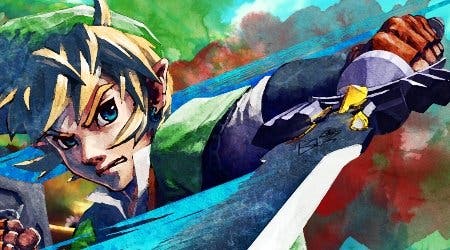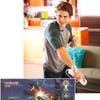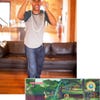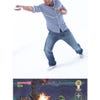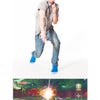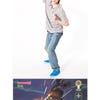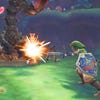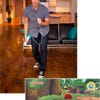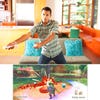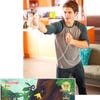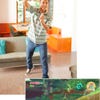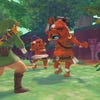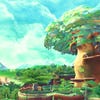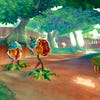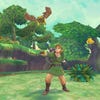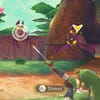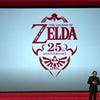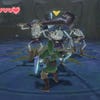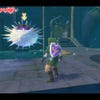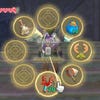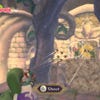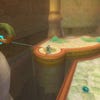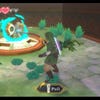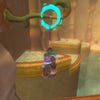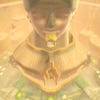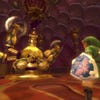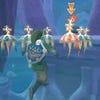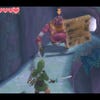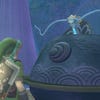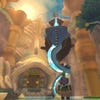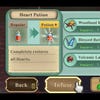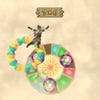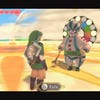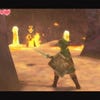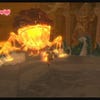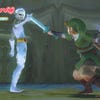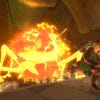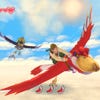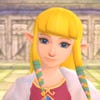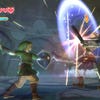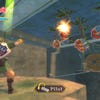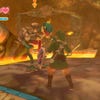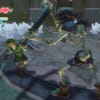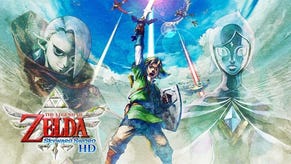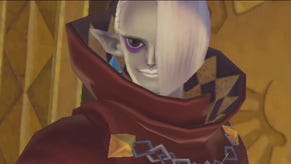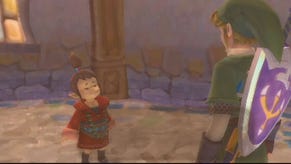The Legend of Zelda: Skyward Sword Review
Lofty.
And so it was foretold. A great evil that once terrorised the land shall threaten to rise again. The gods that vanquished the evil in ancient times sealed the power needed to thwart it in a great sword and a mysterious symbol. A hero chosen by those gods shall undergo many trials to claim that power for himself and save the future of the land, and the future of a girl with whom his fate is intertwined. This is the story that has been handed down for generations.
"Oral history - the most unreliable method of transferring information," remarks Fi, your familiar and guide in The Legend of Zelda: Skyward Sword. (She's an ethereal automaton who lives in your sword, part Navi, part Cortana, and though she's impassive and exact in all things, she's not above the odd tart line.) But it's proven a reliable enough tale in the 25-year history of Nintendo's classic fantasy adventures.
Nintendo supposedly keeps a timeline that ties these clockwork fairy tales together into some sort of coherent whole, but I don't buy it. Sure, there is the rare exception of Majora's Mask: an actual sequel to Ocarina of Time, and not coincidentally the least formulaic and most experimental game in the series. But for the most part, Zelda games are echoes of each other, handed down from one (console) generation to the next, changing the context but not the form.
For all their epic sweep, they are more rituals than stories. If the Super Mario games are all about breaking the rules, Nintendo's other great series is about observing them: players and game designers alike following intricate pathways of logic to their roundly satisfying conclusions. Zelda games are never without mystery or surprise, but they are always the same, and for those who've lived with them for even half their quarter century, they're getting pretty familiar.
Can Skyward Sword - likely to be a swansong for Nintendo's core development teams on Wii - do anything to make this formula feel fresh? The short answer: yes it can.
But it doesn't do so by rewriting the order of service. (It hardly constitutes a spoiler to say that your first stop is a forest temple, your first tool a slingshot.) Instead, Skyward Sword joins motion control innovation and subtle restructuring together to make this the most effortless, breathless, free-flowing Zelda game since 1991's A Link to the Past on Super Nintendo. It doesn't just sustain this pace, but builds it, over the course of a quest that could easily take you over 50 hours to complete.
It's also an unabashedly youthful and romantic game that bursts with colour, comedy, sentiment and flippant joy. This year's Link may be the rangy teenager model rather than the cute moppet, but the world around him is very much the breezy, bustling cartoon of Wind Waker and the DS games. The sombre tone of Twilight Princess is swept aside and the ghost of Ocarina is, at long last, laid to rest. This one's quite rightly for the kids - in all of us.
In this telling of the old tale, a Goddess saved her people from war with demons by making a home for them on an island in the sky. That's where we join Link, riding his great Loftwing bird and training to become a knight of Skyloft. Zelda isn't a princess, but is his childhood friend and his headmaster's daughter.
The game stays in the sky for a while for a story-led introduction that is long but delightfully unforced. It piles on the romance between the young sweethearts before Zelda is inevitably snatched away and Link discovers that the mythical land beneath the clouds is real; he dons his green uniform and goes down there to find her.
For the first part of the game you're not trying to rescue her from some distant threat, you're just desperately trying to be reunited with Zelda, tracking her across the weird and impenetrable world below (you follow her signal with the new 'dowsing' ability which allows you to track certain things in a first-person view with the point of your sword). Skyward Sword is more explicitly a love story than any Zelda before it - more than most video games dare to be, in fact. The leads share great chemistry, if much less screen time than the innocent pals of last entry Spirit Tracks.
In fairly strict adherence to Zelda form, your search takes you from enchanted woodland to fiery volcano to ancient desert, and ultimately to a dungeon and boss fight in each. It's business as usual, predictable in its brilliance, although the same can't be said of a memorable duel at the end of the first dungeon with Link's nemesis, Demon Lord Ghirahim: a wonderfully distasteful villain, an effete creep with The Human League's fashion sense and a lascivious lizard tongue. One new gadget also stands out at this early stage: the Beetle, a remote-controlled drone that can be used to scout inaccessible areas.
Things pick up considerably in the third zone, Lanayru Province. Here, Timeshift Stones allow you to move from the desert's barren present to its lush past (although with its quizzical robot inhabitants and the vast, high-tech mining facility that constitutes the third dungeon, it seems more like a future). These have a very localised effect, so instead of switching between worlds as in A Link to the Past or Ocarina of Time, both eras mingle, and you can even eventually carry a pool of the past around with you. Although less integral to the game than time travel was in Ocarina, say, it's a dazzling effect and leads to many ingenious riddles.
Then, around halfway through, Skyward Sword changes gears. Instead of repeating the well-worn flow of field exploration to dungeon to boss in new areas, it remixes and expands the three zones you already know - and becomes more fluid and unpredictable.
The blurring of the boundary between the traditionally tricksy dungeons and the unusually dense, involved design of the adventure fields - already noticeable early in the game - becomes even more pronounced. There's some thrifty re-use of earlier segments, for sure, but also several new play styles and some spectacular coups de grâce. Your second trip to Lanayru is the highlight of the game, a thrilling mini-adventure culminating in a terrific dungeon that isn't really a dungeon at all.
Although you're going back to places you've already been, few Zelda games have moved forwards with such purpose, such up-tempo pace. Skyward Sword is reminiscent of Okami (by far the best attempt outside of Nintendo to develop the Zelda template) in its giddy, onrushing momentum, its seemingly never-ending fountain of novelty and adventure. Even when you think it's built to a crescendo, it turns out there's more to come.
Unlike Okami, however, you can always take a break by returning to the sky, a hub and overworld in the vein of Wind Waker's sea or Spirit Tracks' rail network. Despite its apparent grandeur, it's quite compact, and outside of Skyloft town there's not much to do but gloriously swoop your aerial steed around and skydive onto floating islands for a mini-game or a spot of treasure hunting. It's very refreshing all the same.
As well as sticking your nose into the townsfolk's sweet and characterful side-stories, in Skyloft you can sell the bugs and treasure you collect, or use them to upgrade your potions and - a series first - your gear. Having a better bow, faster beetle or more handsome and durable shield is a far more compelling draw than the modular ship and train customisation of the DS games. You can also mix and match different shield types, potions, perk-bestowing medals and extra ammo capacity in the limited slots of your adventure pouch, creating a custom character build for different types of adventuring.
These are hardly deep role-playing systems, but they're great fun to tinker with. They also make the trajectory of your inventory - always the core of a Zelda game - feel both more focused and more flexible than the straightforward expansion of your abilities in previous entries. A stamina gauge, used for sprinting, climbing and certain attacks, is another exciting addition the design, giving Link's normally very 'flat' control scheme a touch of Mario's inertia and rhythm.
Of course, that's not the only way Skyward Sword gives you a more direct link to Link. Motion Plus, the improved motion control available as an add-on or in the newer Wii Remote Plus controllers, is as integral to this game as the analogue stick was to Mario 64.
It's most obvious in your sword, which tracks your movement of the remote perfectly and without requiring energetic gestures (although you'll get carried away often enough). There's scarcely a single enemy design in the game that doesn't make clever use of your ability to direct attacks with this much intuition and precision, and of course it feels very swashbuckling to use.
Steering your crimson Loftwing through the air with tilts of the remote is another thrill. So is guiding Link's plummeting sky-dives, and so is lashing his whip, and so is delivering a pin-point shot with what must be the most satisfying bow in video games history. Nothing requires you to point at the screen, making for longer, more relaxed play sessions. Sensitivity and response are perfect; reliability is almost there, but you will occasionally need to centre a cursor with a quick tap of the d-pad.
Most importantly, every second is fun. No developer in the world does controls as well as Nintendo when it sets its mind to it, with such pleasurable feedback that simply manipulating the game is rewarding - and no developer designs games around controls so well. Skyward Sword is a world away from the tacked-on waggle of Twilight Princess or Super Mario Galaxy, and by far the most successful synthesis of motion controls with traditional gaming to date.
Alongside this revelation is all the stuff you take for granted in a top-drawer Nintendo release. Stuff like an absolutely perfect dynamic 3D camera which you don't need to control yourself, or rock-solid game performance even on hardware that's approaching archaic, or the fact that you can trust the design of the battles, puzzles and game systems to never, ever cheat you or let you down.
And then there are the production values. Despite the Wii's modest power, Skyward Sword is a very beautiful game, saturated with great artwork in dreamy pastels, rough edges smoothed away by impressionistic, painterly textures and atmospheric haze. Audio is even better. Evocative and richly informative effects are backed by a musical score that's outstanding even by Zelda's lofty standards, and has immense range: soaring orchestral themes, delicate ballads, insistent martial drums and looping abstractions.
Skyward Sword feels like the Legend of Zelda game producer Eiji Aonuma always wanted to make. As director of Wind Waker and Twilight Princess, he first pushed against then tried to imitate the towering Ocarina of Time; now he is simply and confidently stepping away from its decade-long shadow. It is the most formally inventive Zelda in a long time (admittedly, that's not saying a great deal). But it's the game's carefree attitude, quick tempo and warm heart that do the most to make it feel new.
Maybe you've played enough Zelda games by now that even that won't be enough to cleanse your palate. That would be a fair response, but if it's so, this game wasn't made for you. Like a tale told from one generation to the next, the point is to keep the tradition alive for others - and for them, Skyward Sword will surely be the greatest adventure money can buy.
